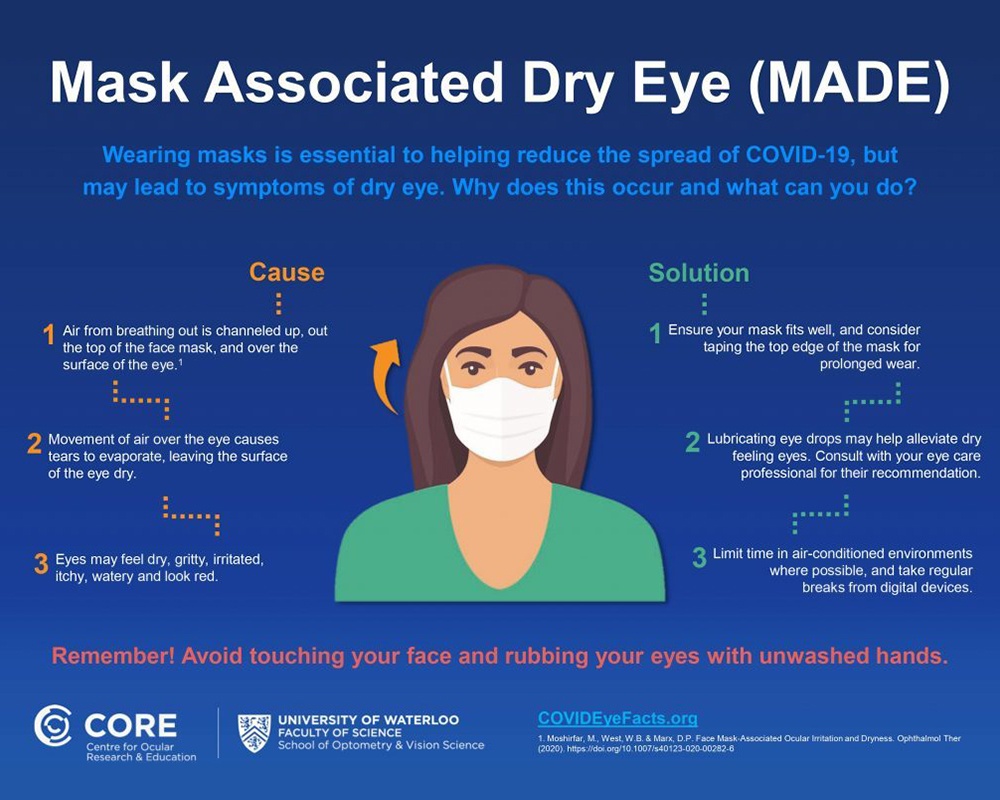Mask Associated Dry Eye

***Wearing face masks is an essential measure for fighting the spread of COVID-19. However, while masks may help prevent illness, they also create problems of their own. One of these issues is mask-associated dry eye. (Known as MADE)
Since early summer, people have reported MADE with growing frequency as they adhere to mask-wearing guidelines. As the need to wear masks isn’t likely to end soon, a large percentage of the population may experience eye irritation and dryness.
What is Mask-Associated Dry Eye (MADE)?
When you wear a mask, it significantly reduces the outward spread of air when you exhale. However, this air must still disperse somewhere. If your mask is sitting loosely on your face, the air that you exhale will likely disperse upward, toward your eyes. If you wear eyeglasses, you’re no doubt aware of this phenomenon—you’ve probably noticed your glasses fogging up with each exhale.
This air that flows upward out of your mask moves over the surface of your eyes, accelerating the evaporation of tears. When your tears evaporate faster than normal, dry spots appear on the ocular surface, which in turn leads to irritation and discomfort.
MADE can exacerbate symptoms in individuals who already suffer from dry eyes, but it affects others as well. People who are most likely to struggle with MADE include those who wear contact lenses, older adults (who generally have lower-quality tear film), and those who work long hours in front of screens or in air-conditioned settings while wearing masks.
Besides the discomfort that dry eyes can cause, MADE presents another serious problem. When your eyes feel irritated, you’re more likely to rub them for relief. Touching your face with unwashed hands (as you may do without thinking when you’re busy or stressed) increases your risk of COVID-19 infection through your eyes, nose, and mouth.
Tips for combatting MADE
If you are experiencing dry eye symptoms, make an appointment with your eye care professional, who can give you recommendations for symptom relief and the prevention of future complications. In the meantime, you can:
- Be sure that your mask fits correctly. Especially if you wear eyeglasses or sunglasses, make sure that your mask sits on your face properly. If you can, consider taping the top edge to your skin to prevent the air that you exhale from blowing directly onto your eyes.
- Use lubricating eye drops. You can buy over-the-counter preservative-free lubricating drops to provide relief for dry eyes. Drops with preservatives are not recommended as these can worsen eye irritation. Ask your eye doctor for a recommendation.
- When possible, keep the amount of time that you spend in an air-conditioned environment while wearing a mask to a minimum. You should also take regular breaks from digital devices throughout the day.
One thing that you should not do is ditch your mask. Wearing a mask responsibly is key to overcoming the pandemic. Understanding MADE and taking steps to prevent it while using your mask diligently is your best move.